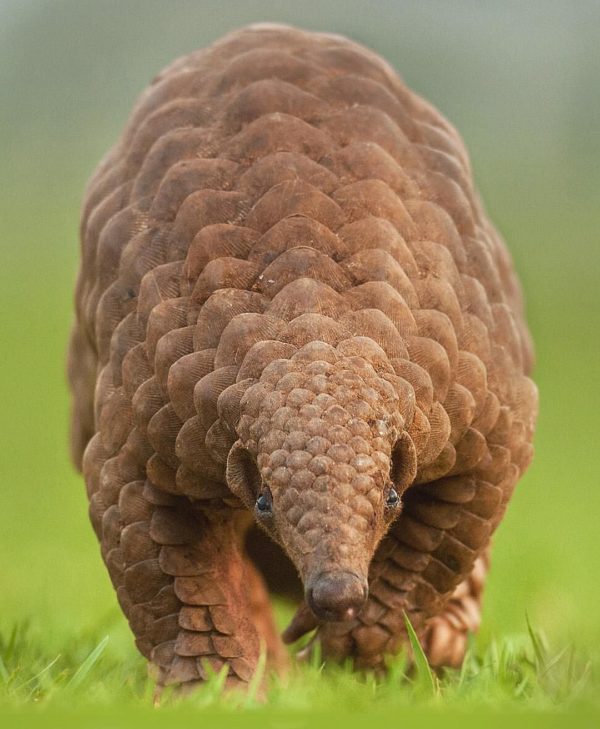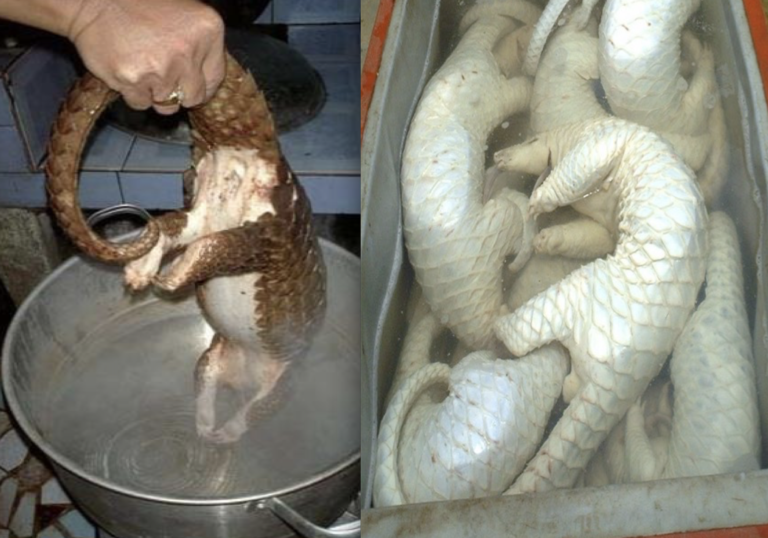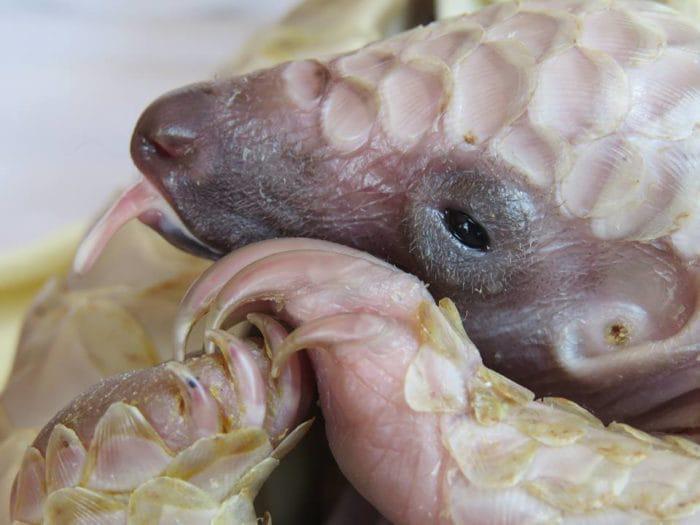By Divya Krishnan

©PBS
Pangolins are the introverts of the animal kingdom. They are nocturnal, solitary and shy creatures and for this very reason, remain elusive to the scientific community at large. Amongst the 8 species surviving across Asia and Africa, they range from a weight of 1.6kgs to a maximum of 33 kgs and are coloured in the pale yellows and browns of spring, to the olive tones of autumn. Imagine an artichoke that walks, you now have a pretty good idea of what these beautiful scaly anteaters look like.
Named in apt accordance to their diet, ants and termites comprise their daily grub. They are more than equipped to hunt these miniscule invertebrates thanks to their long, muscular and adhesive tongue that can retract into a sheath in its thorax! Their digestive system is no less remarkable, their muscular stomachs comprising of inward projecting keratinous spines that aids in mashing and grinding prey with the help of small stones.
As a matter of fact, the entire dorsal surface of their body is embraced in keratinous scales that acts as a protective armour against predators. As much as they sound like beasts from a science fiction movie, they retain an inarguably endearing and winsome disposition that evokes the same response as that of a newborn puppy. With their small, conical heads, toothless and wide-eyed; and their short, stout limbs that shuffle them forward like a toddler that has just mastered the skill of walking without falling on his face, they appear deceivingly naïve.
Despite their gait, affected by the need to walk on the very edges of their forelimbs, as their fore-paws are armed with three sharp and curved nails of considerable length, pangolins can run, climb and swim with surprising speed and agility, their prehensile tail equipping them with a 5th limb when required.
Another astonishing fact about these animals is that they are more closely related to animals in the order Carnivora (cats and dogs) than Xenarthrans (anteaters, armadillos and sloths) whom they share a considerable likeness with. Pangolins belong to the family Manidae, within the order Pholidota.
The eight species are equally distributed in the two continents of Asia and Africa with the former encompassing the Chinese Pangolin, Sunda Pangolin, Indian Pangolin and Philippine Pangolin and the latter, the Cape Pangolin, White-bellied Pangolin, Giant Ground Pangolin and Back-bellied Pangolin. The only notable difference between the Asian and African species is the presence of thick bristles that emerge from between the scales of Asian pangolins.
Spread across the tropical forests of Asia to the savannahs of Africa, they are well adapted to a wide range of habitats and nest in burrows that they make, pretty much anywhere, from underground to within tree trunks.

© Shaaz Jung
Although they like to avoid trouble by staying out of it, they are also well-prepared for a predatory attack as they can roll into an almost impenetrable ball when threatened. This is, as one would expect, the exact instinct that poachers take advantage of. Now that I have, hopefully, and sufficiently, bonded you to the idea of these enigmatic creatures, let’s go through the tragedy of their situation in the world right now, together.
Almost unbelievably, illegal pangolin trade currently exceeds that of both rhinos and elephants combined! Pangolins are poached for their scales, which are sold for their “medicinal” qualities and magical powers; as well as their meat, to satisfy the ever-bored pimp that is the human tongue. It is a source of true amazement, that the so-called most intelligent and emotionally developed species in the world can remain so ignorant to the traps of superstition and the plight of another species. It is estimated that over one million pangolins have suffered in the claws of gluttony and ignorance in the last decade.
Poachers hunt pangolins with the help of trained dogs, that sniff-out the location of these innocent victims in hiding. As soon as the pangolins ball-up in defense, it is just a matter of picking them up and tossing them into a bag. No guns, no arrows, no lasso, just one pocket knife, and a bag. The pangolin when curled up, is very difficult to kill because the scales provide quite a high degree of protection and their muscles are strong enough to keep them curled for sustained periods of time. Mothers will curl up to encompass their babies to protect them when sleeping and when in danger.
So, the poachers proceed to pluck the scales off- one by one. Scales are like fingernails. They are made of the same substance as well and hurt just as much as if someone were to pull your nail off by the bed. Not to mention, they have hundreds of scales. Hundreds to pull off – one by one. Once they have stripped the animal of its divine vestments, they slit its throat, and let it die, sometimes on the table, in front of the customer, before they cook it and sell it as an exotic delicacy.
There is, of course, an alternative method that involves stroking the animal until it feels comfortable enough come out of its protective posture… and then you slit its throat as it looks you directly in the eye.
I stand unapologetic for the gory imagery as the picture my words paint is true.

© NatGeo/TRAFFIC
An organism that has existed for more than 40 million years is presently bordering on extinction. It has taken us less than 200 years, with the earliest record of poaching dating back to the 1820s in the form of a coat and helmet adorned with the scales of the Indian Pangolin, Manis crassicaudata. It was presented as a gift to King George III by Francis Rawdon, the then governor-general of Bengal. It is a matter of small but significant satisfaction that these scales are not “in vogue” among the current generation of designers.
However, if anything good can come from the mass murder of a species, the rapid and enormous decline in the population of pangolins across the world has alerted the attention of various conservation bodies. Pangolins successfully made the jump to fame from being shy and alive to popular and critically endangered. In small installments, measures have been taken to ensure the protection and survival of the remaining pangolin population.
In 1931, the Sunda pangolin, Manis javanica, received protection under Indonesian legislation. In 1975, Asian pangolins were listed under Appendix II in the Convention on International Trade in Endangered Species of Wild Fauna and Flora (CITES), which allowed international commercial trade to be carried out in regions, only where the wild population will not be detrimentally affected. However, in 2008 it was brought to light that the international smuggling of African pangolins was occurring on an industrial scale. This was the final call for resolution and in 2016, pangolins were listed under Appendix I in CITES, thereby banning all international commercial trade and ensuring that the pangolins receive the highest forms and priorities of protection from the conservation authorities.
Despite these measures, large shipments of pangolins are continually being smuggled and seized. In 2017, three shipments were seized by national authorities in China, Hong Kong, and Malaysia, the collective estimate being around 100,000 African pangolins and the largest of these shipments weighing 12 tonnes- the biggest single shipment ever recorded.
These seized pangolins are now being used to research further into the species to help conservation authorities get a clearer image of their functioning mechanisms. Veterinarians, such as Dr. Christine Styne of the University of Pretoria, are using these cadavers to learn more about the anatomy and physiology of this animal. The advancement of veterinary technology, such as XRAY, MRI, and CT scanning, allows for the imaging of the internal structures, penetrating the thick, keratinous scale layer. Understanding the physiology and biochemistry of the various anatomical structures will eventually allow for the breaking of baseless superstitions or the discovery of alternatives, specifically in the field of traditional medicine.

Baby pangolin developing scales © Tikki Hywood trust
If there is a silver lining in this dark cloud, it lay embedded in the fact that every life lost has contributed to throwing light on the unsustainable trade and poaching of wild animals that has been occurring behind closed doors for much too long. Whether these lost lives will translate into creating longer lives for their brothers that remain… that is a responsibility that lies with each and every one of us.
When encountered by the illegal trade of life, whatever life it may be, keep in mind the following three guidelines:
REJECT
REPORT
RESTORE
The pangolin’s plea and the pangolin’s plight shall be answered by the angel’s might in the devil’s fight.
Divya Krishnan is an aspiring veterinarian studying at the University of Queensland. She is driven by her love to make a difference in the world for animals, conservation and towards social work. Her pursuits have taken her to work at the best veterinary hospitals, different parts of India and Uganda, working with adults and young children. She is also a singer and a dancer.